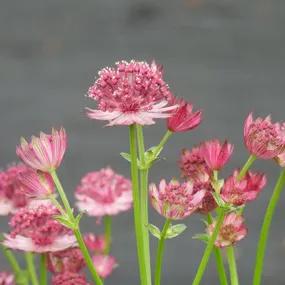Roma Greater Masterwort Plants
The details
Astrantia major
Pot Grown Herbaceous Perennials- Greater Masterwort.
- Pink, "pincushion" compound flowers.
- Flowering: May-Sept
- Foliage: Deep green
- To 75 x 50cm
- Thrives in partial shade
- Any well drained soil
- RHS Plants for Pollinators
Recommended extras
Description
Astrantia major Roma: Masterwort Plants
A compact, dappled shade-tolerant perennial with attractive, mostly pink star-shaped, paper flower heads with a "pincushion"-like centre. Blooms from May through to September, and have a lovely mobility in the breeze adding a bit of wildflower-meadow style sheen to the garden. To 75cm tall.
Browse our range of perennial plants.
Features
- AKA Greater Masterwort or Hattie's Pincushion
- Pink and white "pincushion" compound flowers.
- Flowering: May-Sept
- Good for cutting & drying
- Foliage: Deep green
- To 75 x 50cm
- Thrives in partial shade
- Almost any soil, good beside water
- RHS Plants for Pollinators
Growing Roma Masterwort
Astrantia thrive in sheltered borders with dappled shade: they only need a little sun to flower well. In the wild, they will grow near the coast in sheltered conditions and cool meadows near streams. They are happy on any well-drained soil enriched with humus.
Water well and allow to dry out after each watering - they do not like their roots sitting in water. Once established, they are fairly drought resistant.
Cut everything back in October after the last flowers fade in order to encourage new foliage. They are great self-seeders, so use deadheading as a "brake": when you want them to spread, don't deadhead! When they fill the space you have planned for them, prompt deadheading will keep them under control and encourage even more flowers.
In Your Garden Design
Classic Cottage Plants which are as brilliant in pots as they are in shady borders which make them fabulous companions for hostas, hellebores, ferns, foxgloves, geums and salvias. They are wonderful under small garden trees, especially fruit trees where they can be planted alongside comfrey and other shade-tolerant perennial plants.
Planting Instructions
Position in full sun in well-drained soil enriched with humus planting 60cm apart. Avoid spots affected by winter waterlogging. Water until established, then drought tolerant. Protect from slugs. Suitable for containers.
Apply a general fertiliser and a mulch in spring. Divide mature clumps in spring.
Did You Know?
Medieval storytellers described flowers like Astrantia as "stars fallen to earth", and by Victorian times it picked up more common names like Melancholy Gentleman and Hattie's Pincushion.


